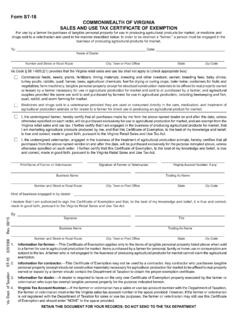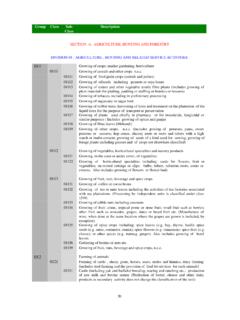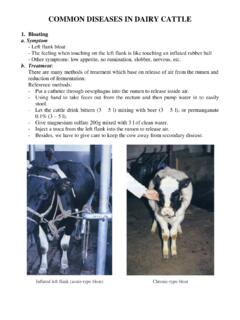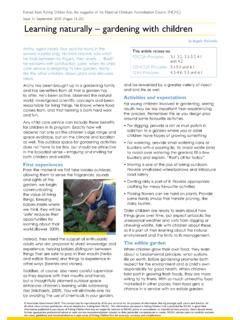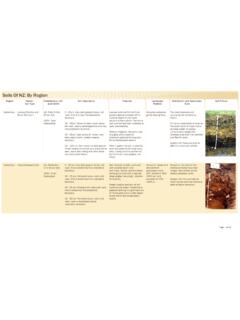Transcription of PIGGERY PRODUCTION MANUAL - Africa Innovations Institute
1 How to Rear Pigs UsingorApril 2016 Africa Innovations Institute , Kampala, UgandaApril 2016 Africa Innovations Institute , Kampala, UgandaThe Deep Litter System (DLS)Fermented Bed TechnologyPIGGERY PRODUCTION MANUALPIGGERY PRODUCTION MANUALA frica Innovations Institute , PIGGERY PRODUCTION ManualAfrica Innovations Institute ( ) is a non governmental center of excellence dedicated to research and Innovations for the betterment of resource poor farmers and the sustainability of the Citation:AfrII 2016 PIGGERY PRODUCTION MANUAL : How to Rear Pigs using The Deep Litter System (DLS) or Fermented Bed Technology (FBT). Africa Innovations Institute , Kampala, 54pp C Africa Innovations Institute . All rights Innovations Institute , PIGGERY PRODUCTION ManualTABLE OF of of common Uganda s PIGGERY .. Common pig husbandry The pork market in uganda.. Challenges and .. Purpose of this Starting a PIGGERY Pig PRODUCTION as a.
2 Types of Pig PRODUCTION Extensive or Free-Range (Scavengers).. Intensive PRODUCTION Types of PIGGERY The Fermented Bed Technology (FBT).. Why use .. The advantages of the Fermented Bed Materials needed for starting up an Breed Selection of right pigs for Pig housing and Housing Factors to consider when selecting site for good Components of a pig housing The .. Space Feed and water Construction of an FBT Site .. Setting and building up the Pig Introduction of bedding material and Preparing IMO and inoculating the Introducing the piglets to the Management of the bed..16 Maintenance of the pig Maintaining a healthy fermenting Cleaning and Repair Water Feeds and feeding iiAfrica Innovations Institute , PIGGERY PRODUCTION Importance of feeds and Nutrients required by Feedstuffs: the source of Ration Care in Feeding Pig feed Sources of pig Practical feeding Management of Management of the Management of the.
3 Key points to .. Care before a Sow is When to serve a Sow on Management during Signs of Management during and immediately after Problems related to farrowing and their Important events in sow management after Management of . Other important points in the management of Fostering piglets to a .. Recommended targets to Pig Weight Estimation Measuring growth of your .. Growth performance of your ..326. Health and disease Types and main diseases of pigs in .. Controlling diseases in Prevention is better than Treatments of diseased ..367. Good records Importance of good record keeping in pig How to keep .. General record .. Sow record Growing or finishing record Boar record .. A Keeping health Financial Preparing a summary of Benefits of good record Pork: quality and Markets and Carcass and meat Meat Case Study: Beginning a pig farming enterprise using FBT).
4 45iiiAfrica Innovations Institute , PIGGERY PRODUCTION Starting the pig PRODUCTION Executing the Challenges which I met.. Future Literature Annexe1. Example of standard pig Innovations Institute , PIGGERY PRODUCTION ManualThe views expressed in this publication are those of the author(s) and do not necessarily reflects the views of the Africa Innovations Institute (AfrII).All rights reserved. Reproduction and dissemination of materials in this information product for educational or other non-commercial purposes are authorized without any prior written permission from the authors provided the source is fully acknowledged. Reproduction in this information product for resale or other commercial purposes is prohibited without written permission of the authors. Applications for such permission should be addressed to: The Chairman, Africa Innovations Institute , 1544 Koire Close, Box 34981, Kampala, Uganda; or to: DISCLAIMERvAfrica Innovations Institute , PIGGERY PRODUCTION ManualPig PRODUCTION is an enterprise that provides small scale subsistence farmers with a clear opportunity for increased household income.
5 It does not require large areas of land; at least 16m2 is needed to raise ten pigs using Deep Litter system or Fermented Bed Technology. The benefits of Deep Litter System or Fermented Bed Technology are many. Generally, it makes it possible for farmers to produce high quality pork more cheaply and in an environmental friendly way. This MANUAL has been prepared as a direct response to findings by a trans-disciplinary team of researchers from Africa Innovations Institute (AFRII) while implementing a three year Rockefeller Foundation funded project in Nakasongola and Nakaseke Districts entitled Securing livelihoods in the cattle corridor of Uganda . During the livelihood profiling of the communities in the two districts, it emerged that the community in the two districts were engaged in and interested in pig PRODUCTION but its full potential was not being realized as a result of the following challenges: reduced land for farming ; poor breeds; traditional feeding and husbandry practices; infestation by worms and poor disease management; limited technical knowledge leading to in-breeding and slow growth rates; high worm infestation, and social conflicts between pig farmers and crop communities.
6 They requested for help in addressing these challanges. To address some of the above challenges and expectations for knowledge and information on improved pig farming practices, better markets and increased household incomes, AFrII constituted a team of researchers to produce this MANUAL . It is meant to guide our farmers engaged in rearing of pigs using the Deep Liter System commonly known as Fermented Bed Technology (FBT). The MANUAL contains only basic information and is in no way intended to be a comprehensive and authoritative document on the PRODUCTION of pigs. Users looking for in depth information are advised to look elsewhere to meet their needs. Chapter one introduces the PIGGERY industry in Uganda while chapter two is about considerations before starting a PIGGERY enterprise. Chapter three focuses more on the Deep Liter System (DLS) or Fermented Bed Technology (FBT). Chapters four, five, six, seven and eight are about feeds and feeding management; management of pigs; health and disease control; good records keeping and pork quality and marketing respectively.
7 Chapter nine is a case study on real life experience on starting a PIGGERY is my sincere hope that this MANUAL shall make enormous contributions to building resilience of smallholder farmers and communities and securing their livelihoods against the impact of climate change; and to enable them enjoy increasing income and food security in line with our vision. I recommend this book to current and future generations of farmers with the keen interest in profitable commercial pig PRODUCTION using Fermented Bed Otim-NapeChairman/ Africa Innovations InstituteFOREWORDviAfrica Innovations Institute , PIGGERY PRODUCTION ManualWe wish to recognize the efforts of the research team that implemented the project whose lessons and experiences are captured in this MANUAL . This MANUAL would be incomplete without the invaluable contribution of Prof. C. Rubaire Akiiki, Ms. Mukasa Beatrice, Byenek S Ogwal, Lutwama Vincent, Richard Lumu, myself and project support staff who in one way or the other contributed to the compilation of this MANUAL .
8 Special thanks go out to participating communities, the Local Governments and PRODUCTION staff of Nakaseke and Nakasongola and technical editing of the MANUAL has been done by S. Ogwal and W. Otim Nape respectively. This MANUAL has been published with support from the Rockefeller Foundation. On behalf of Africa Innovations Institute , I would like to extend our deepest appreciation to the Foundation for their financial and technical support; and for a great service to humanity. Professor Otim-Nape and Byenek Ogwal SimonAfrica Innovations Institute , Kampala, UgandaACKNOWLEDGEMENTviiAfrica Innovations Institute , PIGGERY PRODUCTION ManualAfrII: Africa Innovations InstituteASF: African Swine FeverFMD: Foot and Mouth DiseaseDLS: Deep Litter SystemFBT: Fermented Bed TechnologyIMO: Indigenous Micro OrganismsAM: Anti MeridianPM: Post MeridianPSE: Pale Soft ExudateLIST OF ACRONYMS viiiAfrica Innovations Institute , PIGGERY PRODUCTION ManualAcaricide: A chemical used to control ticks, mites and other ecto-parasitesBarrow: Castrated male pigBoar: Mature intact maleCastrate: Removing the testicles Colostrum: The first milk produced after furrowing (birth of piglets).
9 It is very high in proteins, vitamin A and immunizing agentsConstipation: An abnormality in passing out feaces. It is characterized by abnormally hard feed: Baby pig feed provided in the creep area beginning at about two weeksCreep area: Area within a sow pen so constructed that the piglets can enter and leave but the sow does not have accessDam: Mother or female of an : Chemical agent used to kill microorganismsDry sow: Sows that are not suckling pigletsEstrus: Time during which the female is sexually receptive to the male. Farrow: To give birth to a litter of pigletsFeed conversion rate: Amount of feed required by a pig to produce 1 Kg increase in body weightFeeder pig: Young pigs sold after weaning for growing to reach slaughter weightFinishing pig: Young pig generally weighing more than 60 : Practice of increasing feed allowance around time of serving (mating with boar) to increase number of eggs : Transferring of piglets to be raised by a sow other than their own motherGender: A term used to describe roles of men, women and childrenGilt: Young developing female pigGrowing pig: Young pig after weaning, generally weighing less than 60 KgHand-mating: Supervised mating whereby sow observed on heat is taken to boar for serviceHeterosis: Phenomenon whereby the performance of offsprings from parents of two different breeds is higher than the average performance of the parentsLactation: Period between birth and weaning when the sow suckles her pigletsLimit feeding.
10 Weighing out a determined amount of feed to be given to each pig per day as a way of preventing them from getting too : Set of piglets born to a sow at a timeLitter number: Number of times a sow has size: Number of piglets in a given : Ability of a pig to remain productive in the : A skin disease caused by mites leading to intense : Room in a pig house to be occupied by an animal or group of : Mating in which a breeding female is housed together with a boar and mates with them as and when they come on OF COMMON TERMINOLOGIES USEDixAfrica Innovations Institute , PIGGERY PRODUCTION ManualPiglet: Young pig before weaningRooting: A habit among pigs where they dig up the ground using their snoutsRunt piglets: Small weak piglets within a litter, which are less than average in weightSlaughter pig: Young pig ready for slaughter, usually 90-120 : To tie a pig with a rope it can only move within a specific : Mature female : Remove the piglets from their dam to end pig: Young pig at or shortly after weaningWithdrawal period: Time period within which if a drug is used on an animal, the animal should not be slaughtered for meat to avoid drug resistance in Innovations Institute , PIGGERY PRODUCTION Manual11.
